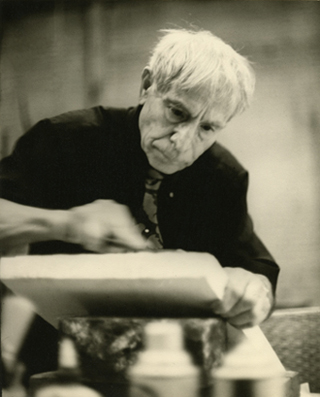|
 |
|
|
|
|
|
|
|
|
|
|
|
|
|
Bufano
and Mulleian |
|
|
|
|
|
|
|
|
Bufano
would pay many
visits to Mulleian's studio. In one instance,
Bufano posed
his right hand
with the missing trigger finger (which he had
severed himself
and sent to President Wilson in protest of the First World
War) for a drawing
by Mulleian. On another occasion Bufano visited
the artist to see Mulleian's latest painting,
a six foot by four
foot work entitled
"Forsaken Paradise". In
high admiration of the painting,
Bufano would bring many of his friends to view this and other Mulleian works
displayed there, often drawing his guest's attention to various aspects
of rendering, technique and detail. |
|
|
|
|
|
|
On
another occasion, after climbing up a wall-mounted ladder and stepping onto
the broad entrance to Mulleian's overhead loft, gesturing to the precipitous
drop behind him, Bufano remarked: "Be careful not to step back too far while
studying your current painting on it's easel!",
as in fear that Mulleian would fall out of his studio. |
|
|
|
|
|
On yet another occasion, author Leonard Ray Frank, Leo
Hills, (owner of the Continental Gallery in San Francisco, which featured the
works of the two artists) and Mulleian, were to show up at Bufano's studio on
Minna Street at seven A.M. to help Bufano move one of his latest sculptures,
titled "St. Francis of Assisi", to Muir Woods. Bufano had called Leo the night
before instructing him to bring a pipe to be used
as a lever in aiding the moving of this three-ton sculpture. A large
truck was already there waiting when we arrived. Bufano was quietly
|
|
|
|
|
pacing
back and forth in anxious anticipation under the studio's large wooden rafters,
highlighted by dusted light beams from the old French skylight far above. When
Bufano suddenly stops in front of Leo Hills and asks: "Did
you bring the pipe?" Leo then reaches into his inner suit pocket and meticulously
pulls out a small eight inch pipe, which Bufano,
with
all of his four feet, seven inches of Roman wrath, grabs and vigorously throws
clear across his studio with all the fury of a thunderbolt,
and in his heavily Italian-accented antics, asks: "How can I move a three ton
statue with that!" After the dust settles and Bufano regains his composure,
we all start out with Bufano's St. Francis tied down to a flatbed truck, headed
toward its final destination, Muir Woods.
|
|
|
|
Optimism
was Bufano's natural impulse. Negativity was not in his vocabulary. Exasperation
was an unnatural byproduct of momentary circumstance, as ephemeral and spontaneous
as a thunderstorm in summer, and enduring just as long. Bufano's legacy is forever
timeless, his quest for world peace forever transcendent, and the relevance
of his vision of world peace greater now than ever. |
|
|
|
|
|
|
 |
|
|
|
|
|
 |
 |
 |
 |
 |
 |
 |
 |
 |
 |
 |
 |
 |
